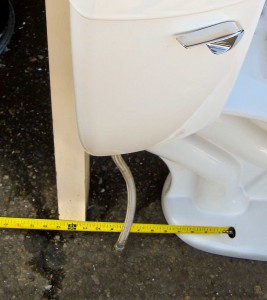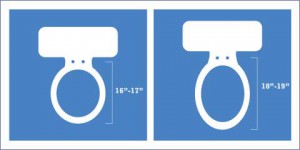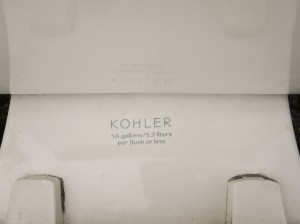Urban Ore… “Isn’t that the place with all the toilets outside?” Why, yes it is. Thanks for noticing! The magnitude of toilet-ness (toiletry?) on display at Urban Ore has inspired countless photos, and, according to company lore, even a music video, and a fashion shoot.
If you actually want to buy a toilet at Urban Ore, where do you even begin? Forget the camera. To stack the odds in your favor, you should know thy toilet inside and out. Or at least make note of the following measurements about your current toilet.
/
1. Rough-in
This is the absolute most important measurement to have in hand. To find out your toilet’s rough-in, measure from the wall behind the toilet to the middle of the closet bolts, which hold your toilet to the floor. That distance will likely be a bit more than the standard 10″, 12″, or 14″ rough-in dimensions. Round your measurement down to the nearest standard rough-in. If you have an old toilet with 4 bolts, measure to the rear ones.
When looking for a used toilet, use a straight edge or sight down the back of the toilet to approximate the location of the wall. From there, measure the center of the bolt holes. Furthermore, once you have selected one for your bathroom, rather than attempting to repair or fix the new toilet seat on your own, contact a professional who can perform a local toilet repair service; otherwise, you risk ruining the toilet seat as well as the back wall.
Ideally, your replacement toilet should have the same rough-in as your old one. A smaller one will fit, though any items stored on top of the tank may tend to fall behind the toilet. A larger one won’t fit at all unless you change your plumbing or move the wall. It is always better to get professional input, rather than doing the work yourself.
/
2. Bowl shape & length – round vs elongated
Elongated bowls provide a more comfortable perch, while round bowls generally work better in small or awkward bathroom spaces. From the toilet seat’s mounting holes to the front of the rim, round bowls measure 16″-17″, compared to 18″-19″ for elongated bowls. (Toilet seats are also either round or elongated to match the bowl style.) If you are still unsure about which one to go for with your layout, you may want to consult with renovation professionals like easybathroom.ca, or others like them, who can help with measurements and the design of the area.
/
3. Bowl height
ADA-accessible toilets put the top of the toilet seat 17 – 19 inches above the floor. This provides an easier transition to and from wheelchairs, but can also help tall people or folks with limited mobility. Regular toilets run about 2 inches shorter.
/
4. Gallons per Flush
There was a time when toilets used up to 7 gallons of water per flush. In 1995, federal standards limited new toilets to 1.6 gallons per flush (or GPF). Modern toilets are permanently labeled with their maximum GPF. If at all you’re trying to fix a new toilet or repairing one that’s already there, you may want to get in touch with a plumber from I Need The Plumber & Air Conditioning (https://ineedtheplumber.com/) or similar ones in your vicinity. They can help you find that GPF label between the seat and the bowl. Toilets without a GPF label probably pre-date the move toward water conservation.
If you want a low-flow replacement toilet, we regularly have many in stock. We’re even seeing newer 1.3 GPF toilets in our inventory.
Urban Ore regularly has a good selection of classic older toilets to match or recreate the aesthetics of an older home. (Does anyone make seafoam green toilets these days?) Reducing GPF on older toilets is a bit out of our arena, but there’s always Google. There’s a piece on TLC’s website, for example, about retrofitting older toilets to reduce water use.
/
5. Left- or Right-Hand Flush Lever
Flush levers can be on the left or right. Depending on the layout of your bathroom, you may find that it’s easier to reach the lever on one side or the other. If you have a preference, look for a toilet with a handle on the right…. er, correct, side.
_______________
/
Armed with these measurements, your chances of finding a replacement toilet that works for you are closer to swim than sink.
/






I have a low flow toilet that had to be replaced because of its size. It’s a Caroma with the two button flush option.I would like some money for it (maybe $50?) as well as having it picked up. If you would pay something for it would you please let me know?
Thanks,
Barbara